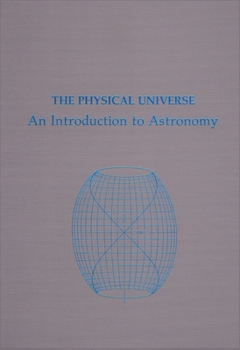The Physical Universe: An Introduction to Astronomy (Revised)
Select Format
Select Condition 
Book Overview
"This is a truly astonishing book, invaluable for anyone with an interest in astronomy and surely the bargain of the year." ---Physics Bulletin "Just the thing for a first year university science course." ---Nature "This is a beautiful book in both concept and execution." ---Sky & Telescope
Format:Paperback
Language:English
ISBN:0935702059
ISBN13:9780935702057
Release Date:January 1981
Publisher:University Science Books
Length:584 Pages
Weight:3.65 lbs.
Dimensions:1.4" x 8.6" x 11.4"
Customer Reviews
4 ratings
Excellent introduction
Published by Thriftbooks.com User , 17 years ago
This book should be titled "Introduction to the physics of astrophysics". As such it is excellent. I used it for many years in an intermediate astrophysics course. The only problem with it is that it is dated in parts (no mention of helio-and astro-seismology for instance), though it is current well into 1982. It would be of great benefit to physics education and to astrophysics education at the intermediate level if Prof. Shu would bring out an updated edition!
A classic astronomy and astrophysics textbook
Published by Thriftbooks.com User , 19 years ago
This was a superb textbook when it appeared over twenty years ago. It begins with some introductory material about microscopic and macroscopic laws of physics. After that, we learn about stars and their evolution. And binary stars. Next are galaxies and galactic clusters. And cosmology and the hot big bang. Then our planetary system. And we finish with life and intelligence in the universe. I read this book when it first came out and truly enjoyed it. But I do want to warn folks that it is getting a little out-of-date and definitely needs a new edition. In the past twenty years, we have made plenty of new discoveries. Topics such as dark energy, the accelerating expansion of the universe, cosmic microwave background anisotropies, gamma-ray bursters and soft gamma repeaters, supernova 1987A, ultraluminous infrared galaxies, extrasolar planets and planetary migration, the Big Splat theory of the origin of the Moon, and inflationary models of the big bang are too new to be in this book. Plenty of work on formation of galaxies is too new as well. Descriptions of and recent results from deep space probes and telescopes are not included. That leaves us with much less to discuss about Uranus or Neptune, not to mention recent in situ observations of Mars or questions about water under the icy surface of Europa. And even topics such as artificial intelligence are discussed without the benefit of the past twenty years of perspective. I still recommend the book. But I wouldn't be able to teach a class on astronomy or astrophysics from this text without supplementing it with a substantial amount of extra material.
Excellent Text
Published by Thriftbooks.com User , 24 years ago
I have this book for 2 years now and it's worth every dollar. I'm an undergrad in theoretical physics and applied mathematics, but astronomy and cosmology are part of my program. This book has really been useful in my studies. It is very easy to use with eloquent philosophical remarks and examples that range from easy to difficult. I recommend this book to anyone starting out in astronomy or astrophysics as it will definitely assist you and allow you to understand the points from their foundation.
An excellent introduction to astronomy for physics majors
Published by Thriftbooks.com User , 25 years ago
This is the book I used in my first year of grad school to make the transition from a physics major to an astronomy grad student. The problems range from very simple (algebraic) to those using calculus, but all are elegant and chosen to illustrate important ideas. This book will give you a back-of-the-envelope acquaintance with a very broad sweep of research areas in astronomy. This book also convinced me that Frank Shu is not only a great researcher, but a great teacher as well.I bought a new copy recently -- my old one wore out. I use it to introduce physics majors and colleagues interested in interdisciplinary work to astronomy. I have also used it to teach extra-bright (TAG accelerated college entrance program) 11-to-14-year-olds some fundamentals of astronomy and physics, and they loved it, too. Good for bright, interested people of any age who are not afraid to try.Subject matter is still up-to-date, as it is theoretical (although based solidly on observations), and does not rely, as many introductory texts do, on the "latest results from The Current Gigantic Telescope Project" for material.




